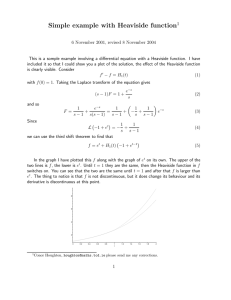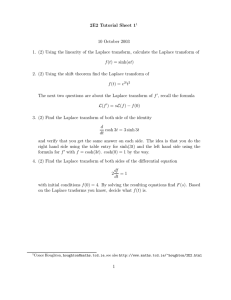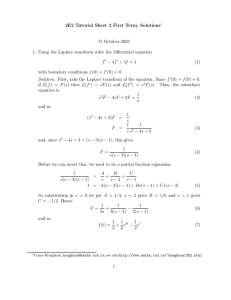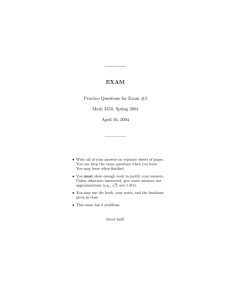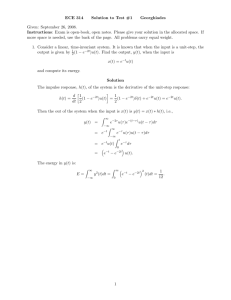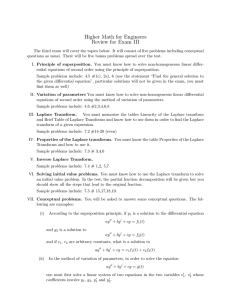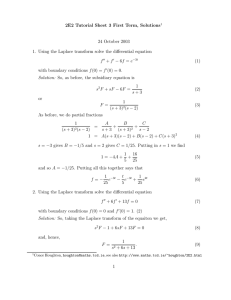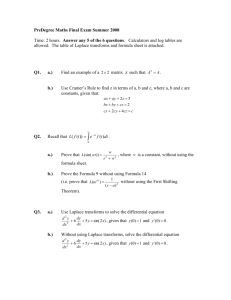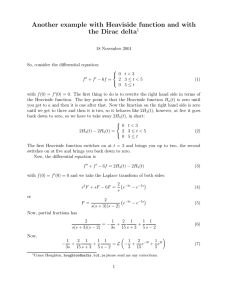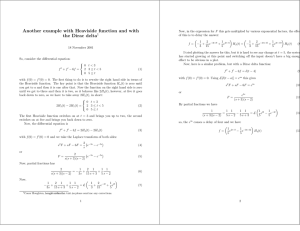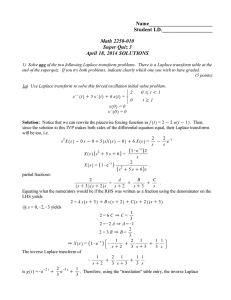2E2 Tutorial Sheet 4 First Term, Solutions 31 October 2003
advertisement
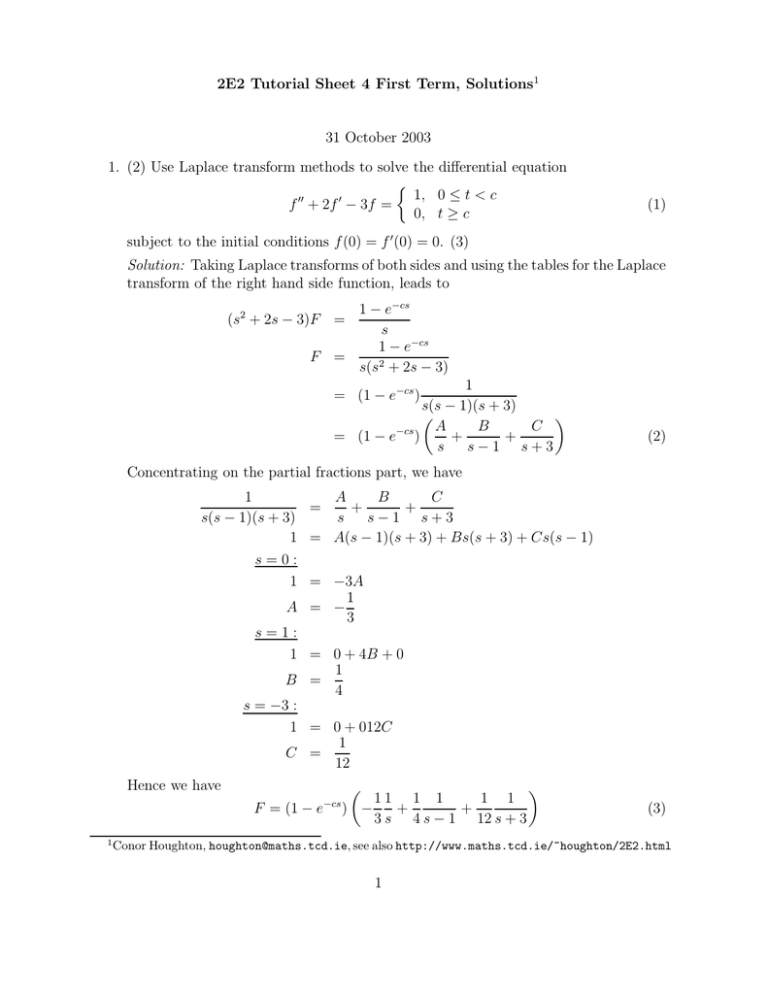
2E2 Tutorial Sheet 4 First Term, Solutions1 31 October 2003 1. (2) Use Laplace transform methods to solve the differential equation 1, 0 ≤ t < c 00 0 f + 2f − 3f = 0, t ≥ c (1) subject to the initial conditions f (0) = f 0 (0) = 0. (3) Solution: Taking Laplace transforms of both sides and using the tables for the Laplace transform of the right hand side function, leads to 1 − e−cs s 1 − e−cs F = s(s2 + 2s − 3) (s2 + 2s − 3)F = 1 s(s − 1)(s + 3) B C A −cs + + = (1 − e ) s s−1 s+3 = (1 − e−cs ) (2) Concentrating on the partial fractions part, we have 1 A B C = + + s(s − 1)(s + 3) s s−1 s+3 1 = A(s − 1)(s + 3) + Bs(s + 3) + Cs(s − 1) s=0: 1 = −3A 1 A = − 3 s=1: 1 = 0 + 4B + 0 1 B = 4 s = −3 : 1 = 0 + 012C 1 C = 12 Hence we have 11 1 1 1 1 −cs F = (1 − e ) − + + 3 s 4 s − 1 12 s + 3 1 (3) Conor Houghton, houghton@maths.tcd.ie, see also http://www.maths.tcd.ie/~houghton/2E2.html 1 From the tables, we know that 1 1 t 11 1 1 1 −3t 1 1 L − + e − e =− + + 3 4 12 3 s 4 s − 1 12 s + 3 (4) and then using the second shift theorem 1 −3t 1 1 (t−c) 1 −3(t−c) 1 1 t + e f (t) = − + e + e − Hc (t) − + e 3 4 12 3 4 12 2. (3) Use Laplace transform methods to solve the differential equation 0, 0 ≤ t < 1 1, 1 ≤ t < 2 f 00 + 2f 0 − 3f = 0, t ≥ 2 (5) (6) subject to the initial conditions f (0) = 0 and f 0 (0) = 0. Solution:So the thing here is to rewrite the right hand side of the equations in terms of Heaviside functions. Remember the definition of the Heaviside function: 0 t<a (7) Ha (t) = 1 t≥a so the Heaviside function is zero until a and then it is one. The right hand side is zero until t = 1 and then it is one until t = 2 and then it is zero again. Consider H1 (t) − H2 (t), this is zero until you reach t = 1, then the first Heaviside function switches on, the other one remains zero. Things stay like this until you reach t = 2, then the second Heaviside function switches on aswell and you get 1 − 1 = 0. Thus 0, 0 ≤ t < 1 1, 1 ≤ t < 2 H1 (t) − H2 (t) = (8) 0, t ≥ 2 Now, using e−as L(Ha (t)) = s we take the Laplace transform of the differential equation: s2 F + 2sF − 3F = e−s e−2s − s s (9) (10) This gives (s2 + 2s − 3)F = F = 1 e−s − e−2s s(s − 1)(s + 3) 2 1 −s e − e−2s s (11) Now, if you look at the soln to problem sheet 4, question 3 you’ll see that 1 1 1 1 =− + + s(s − 1)(s + 3) 3s 4(s − 1) 12(s + 3) and we know that 1 −3t 1 1 1 1 1 t + =− + L − + e + e 3 4 12 3 4(s − 1) 12(s + 3) (12) (13) In other word, if it wasn’t for the expontentials we’d know the little f. However, we know from the second shift thereom that the affect of the exponential e−as is to change t to t − a and to introduce an overall factor of Ha (t). Thus 1 1 t−1 1 1 t−2 1 −3t+3 1 −3t+6 f = H1 (t) − + e + e − H2 (t) − + e + e (14) 3 4 12 3 4 12 3. (3) Use Laplace transform methods to solve the differential equation f 00 + 2f 0 − 3f = δ(t − 1) (15) subject to the initial conditions f (0) = 0 and f 0 (0) = 1. Solution:The only thing that is unusual is that there is a delta function. We take the Laplace transform using L(δ(t − a)) = e−as (16) hence (s2 + 2s − 3)F − 1 = e−s (17) Now, if we do partial fractions on 1/(s2 + 2s − 3) we get s2 Hence F = Since 1 1 1 =− + + 2s − 3 4(s + 3) 4(s − 1) 1 1 − + 4(s + 3) 4(s − 1) 1 1 L − e−3t + et 4 4 =− 1 + e−s (18) 1 1 + 4(s + 3) 4(s − 1) then, by the second shift theorem we have 1 −3t+3 1 t−1 1 −3t 1 t + e f = − e + e + H1 (t) − e 4 4 4 4 3 (19) (20) (21)


